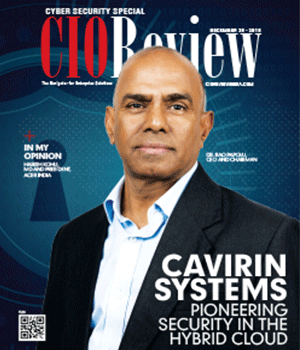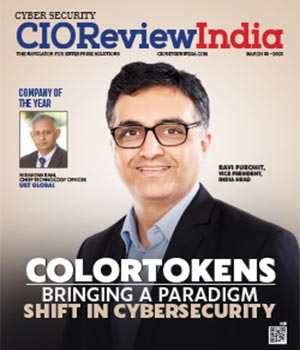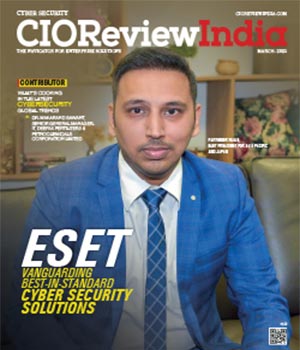
Fortinet Threat Landscape Report Examines How Cybercriminals are Building an Army of Things, Creating a Tipping Point for Cybersecurity
CIOReview Team | Friday, 05 May 2017, 05:12 IST
 System Engineering, India & SAARCat Fortinet
System Engineering, India & SAARCat Fortinet
“The cybersecurity challenges facing organizations today are complex with a threat landscape that is rapidly evolving. Threats are intelligent, autonomous, and increasingly difficult to detect, with newones emerging and old ones returning with enhanced capabilities. In addition, the accessibilty of threat creation tools and servicescombined with the reward potential is driving the growth of the global cybercrime market into tens of billions of US dollars. To protect themselves, CISOs need to ensure that thedata and security elements across allof their environments and devices are integrated, automated, and able to share intelligence, across an organization, from IoT to the cloud.”
News Summary
Fortinet® (NASDAQ: FTNT), the global leader in high-performance cybersecurity solutions, today announced the findings of its latest Global Threat Landscape Report covering Q4 2016. The research reveals that 50% of malware exploits in India occurred in the last 3 months of 2016. With India moving towards a cashless digital economy the last two weeks in December, 2016 recorded a very high level of threat activity which interestingly was not observed globally. The most attacked industry was Banking & Finance which received 15 times more hits than the second-placed Information Technology industry.
The research also reveals the methods and strategies cybercriminals employed in detail and demonstrates the potential future impact to the digital economy. The question, “What’s my biggest threat?” remains difficult to pinpoint as old threats resurface, but new, automated and high-volume attacks arise. For a detailed view of the research visit our blog. Highlights follow:
Infrastructure Trends and How They Relate to Threats
· Considering infrastructure trends and how they relate to the threat landscape is important. Exploits, malware, and botnets do not happen in a vacuum and finding or preventing threats gets increasingly complicated as network infrastructure evolves.
· Data shows encrypted traffic using SSL stayed steady at about 50% and accounted for roughly half of overall web traffic traversing within an organization. HTTPS traffic usage is an important trend to monitor, because while it is good for privacy, it presents challenges to detecting threats that are able to hide in encrypted communications. Often SSL traffic goes uninspected because of the huge processing overhead required to open, inspect, and re-encrypt traffic, forcing teams to choose between protection and performance.
· In terms of total applications detected per organization, the number of cloud applications trended up at 63, which is roughly a third of all applications detected. This trendhas significant implications for security since IT teams have less visibility into the data residing in cloud applications, how that data is being used, and who has access to it. Social media, streaming audio and video, and P2P applications did not trend up sharply.
An Army of Things Powered by the Digital Underground
· IoT devices are sought-after commodities for cybercriminals around the world. Adversaries are building their own armies of "things"and the ability to cheaply replicate attacks at incredible speed and scale is a core pillar of the modern cybercrime ecosystem.
· In Q4 2016, the industry was reeling from the Yahoo! data breach and Dyn DDoS attack. Before the quarter was halfway done, the records set by both events were not only broken, but doubled.
· Internet of Things (IoT) devices compromised by the Mirai botnet initiated multiple record-setting DDoS attacks. The release of Mirai’s source code increased botnet activity by 25 times within a week, with activity increasing by 125 times by year’s end.
· IoT-related exploit activity for several device categories showed scans for vulnerable home routers and printers topped the list, but DVRs/NVRs briefly eclipsed routers as the thing of choice with a massive jump spanning 6+ orders of magnitude.
· Unlike other parts of the world, vulnerabilities in home routers formed the majority of IoT-based attacks in Asia Pacific. Many home routers are manufactured and deployed in this region, resulting in attacks on them being centred here.
· Mobile malware become a larger problem than before. Though it accounted for only 1.7 percent of the total malware volume, one in five organizations reporting malware encountered a mobile variant, nearly all was on Android. Substantional regional differences were found in mobile malware attacks, with 36 percent coming from African organizations, 23 percent from Asia, 16 percent from North America, compared to only 8 percent in Europe.This data has implications for the trusted devices on corporate networks today.
Automated and High-Volume Attacks Are Prevalent
· The correlation between exploit volume and prevalence implies growing attack automation and lowering costs for malware and distribution tools available on the dark web. This is making it cheaper and easier than ever for cybercriminals to initiate attacks.
· SQL Slammer ranked at the top of the exploit detection list with a high or critical severity ranking, mainly affecting educational institutions.
· An exploit indicating attempted brute force attacks on Microsoft Remote Desktop Protocol (RDP) ranked second in prevalance. It launched RDP requests at a rate of 200 times every 10 seconds, explaining the high volume detected across global enterprises.
· Ranking third in prevalence is a signature tied to a Memory Corruption vulnerability in Windows File Manager that allows a remote attacker to execute arbitrary code within vulnerable applications with a jpg file.
· H-Worm and ZeroAccess had two of the highest prevalence and volume for botnet families in Asia Pacific. Both give cybercriminals control of affected systems to siphon data or perform click fraud and bitcoin mining. The technology and government sectors faced the highest numbers of attempted attacks by these two families of botnets.
Ransomware Isn’t Going Anywhere
· Ransomware warrants attention regardless of industry and this high-value attack method will likely continue with the growth of ransomware-as-a-service (RaaS), where potential criminals with no training or skills can simply download tools and point them at a victim.
· 36% of organizations detected botnet activity related to ransomware. TorrentLocker was the winner and Locky placed third.
· Two malware families, Nemucod and Agent, went on a crime spree. 81.4 percent of all malware samples captured belonged to just these two families. The Nemucod family is infamously affiliated with ransomware. In Asia Pacific, the majority of malware infections are related to ransomware droppers such as Nemucod.
· Ransomware was present in all regions and sectors, but particularly widespread in healthcare institutions.This remains significant because when patient data is compromised the ramifications can be much more severe, as it has greater longevity and personal value than other types of data.
Report Methodology
The Fortinet Global Threat Landscape reportrepresents the collective intelligence of FortiGuard Labsduring Q4 2016 with research data covering global, regional, sector, and organizational perspectives. It focuses on three central and complementary aspects of the threat landscape: application exploits, malicious software (malware) and botnets.
CIO Viewpoint
From VPNs to Zero Trust: The Transition to a...
By Shankar Venkatesan, Senior IT Leader, Avalon Technologies
The Cyber Security Spar in Integrating IT and...
By Vimal Goel, CIO, HPCL-Mittal Energy
Towards Cyber Resilience: A Data-Centric...
By Puneet Gupta, Vice President & Managing Director, NetApp India/SAARC
CXO Insights
Emerging Trends, Challenges & Future Prospects...
By Sujoy Brahmachari, CIO & CISO, Rosmerta Technologies
Exploring Data-First Security and Automation in...
By Maheswaran S, Country Manager - S.Asia, Varonis Systems
Securing IT-OT Converged Infrastructure




.jpg)
.jpg)
.jpg)







